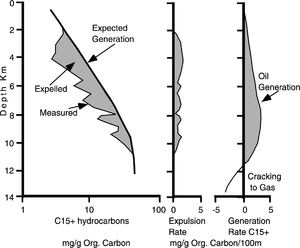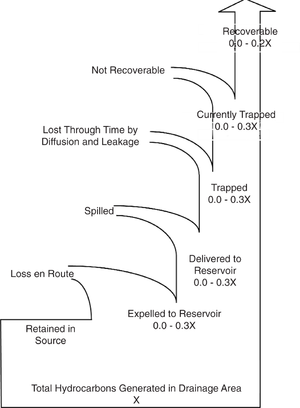Difference between revisions of "Expulsion efficiency estimation"
Cwhitehurst (talk | contribs) |
Cwhitehurst (talk | contribs) m (added Category:Treatise Handbook 3 using HotCat) |
||
| (17 intermediate revisions by 3 users not shown) | |||
| Line 6: | Line 6: | ||
| part = Critical elements of the petroleum system | | part = Critical elements of the petroleum system | ||
| chapter = Migration of petroleum | | chapter = Migration of petroleum | ||
| − | | frompg = 7- | + | | frompg = 7-35 |
| − | | topg = 7- | + | | topg = 7-36 |
| author = Martin D. Matthews | | author = Martin D. Matthews | ||
| link = http://archives.datapages.com/data/specpubs/beaumont/ch07/ch07.htm | | link = http://archives.datapages.com/data/specpubs/beaumont/ch07/ch07.htm | ||
| Line 18: | Line 18: | ||
==Expulsion percentage ranges== | ==Expulsion percentage ranges== | ||
| − | [[file:migration-of-petroleum_fig7-13.png| | + | [[file:migration-of-petroleum_fig7-13.png|thumb|300px|{{figure number|1}}Efficiencies of the expulsion, migration, and entrapment processes. After Magara.<ref name=ch07r5>Magara, K., 1980, [http://archives.datapages.com/data/bulletns/1980-81/data/pg/0064/0012/2100/2108.htm Evidences of primary migration]: AAPG Bulletin, vol. 64, p. 2108–2117.</ref>]] |
| − | Typical oil expulsion efficiencies are estimated to be in the 5-10% range, with values in the 15% range uncommon and 30% rarely demonstrated. This efficiency is low because most of the source rock section contains too low a concentration of organic material to participate in the expulsion process. Efficiencies of gas expulsion are estimated to be 50-90%, with values of 75% common. Unfortunately, much of this is gas lost due to solution and does not participate in reservoir charging. For both oil and gas, expulsion efficiencies tend to increase with increasing TOC. Expulsion efficiencies for oil and gas can be as high as 70-80% for very rich, effective [[source rocks]] near preferential [[migration pathways]]. | + | Typical oil expulsion efficiencies are estimated to be in the 5-10% range, with values in the 15% range uncommon and 30% rarely demonstrated. This efficiency is low because most of the source rock section contains too low a concentration of organic material to participate in the expulsion process. Efficiencies of gas expulsion are estimated to be 50-90%, with values of 75% common. Unfortunately, much of this is gas lost due to solution and does not participate in reservoir[[Calculating charge volume| charging]]. For both oil and gas, expulsion efficiencies tend to increase with increasing [[total organic carbon (TOC)]]. Expulsion efficiencies for oil and gas can be as high as 70-80% for very rich, effective [[source rocks]] near preferential [[migration pathways]]. |
==Procedure== | ==Procedure== | ||
| − | [[file:migration-of-petroleum_fig7-14.png|thumb|{{figure number|2}}. Copyright: McDowell | + | [[file:migration-of-petroleum_fig7-14.png|300px|thumb|{{figure number|2}}Procedure for estimating expulsion efficiency. Copyright: McDowell;<ref name=McDowell1975>McDowell, A. N., 1975, What are the problems in estimating the oil potential of a basin? Oil & Gas Journal, June 9, p. 85–90.</ref> courtesy Oil & Gas Journal.]] |
| − | In migration volumetrics, it is important to estimate the original petroleum potential of the source | + | In [[migration]] volumetrics, it is important to estimate the original petroleum potential of the [[source rock]]—not just its present measured potential (with increasing [[maturation]], a portion of the original potential will have been realized and is therefore unmeasurable). Estimates of expelled hydrocarbons may be derived by measuring the amount remaining in a source and subtracting that value from the amount that should have been generated from the original assumed [[kerogen]] content. |
Below is a procedure for estimating expulsion efficiency. | Below is a procedure for estimating expulsion efficiency. | ||
| − | + | # Estimate the original kerogen content of the rock using [[total organic carbon (TOC)|TOC]] values measured from source rock samples. | |
| − | + | # Model the original [[Petroleum generation|hydrocarbon generation]] potential of the source rock using the estimated original kerogen content. | |
| − | + | # Measure the volume of hydrocarbons expelled during [[Rock-Eval pyrolysis|pyrolosis]] (S2). | |
| − | + | # Estimate the actual expelled hydrocarbon volume by subtracting the S2 value from the original hydrocarbon generation potential of the source rock. | |
| − | + | # Calculate efficiency by dividing the expected volume of expelled hydrocarbons from the actual volume of hydrocarbons generated. | |
| − | |||
| − | |||
| − | |||
| − | |||
| − | |||
| − | |||
| − | |||
| − | |||
| − | |||
| − | |||
| − | |||
| − | |||
| − | |||
| − | |||
| − | |||
==Expulsion diagram== | ==Expulsion diagram== | ||
| Line 55: | Line 40: | ||
==See also== | ==See also== | ||
| − | + | ||
* [[Calculating migration rate]] | * [[Calculating migration rate]] | ||
* [[Calculating charge volume]] | * [[Calculating charge volume]] | ||
| Line 69: | Line 54: | ||
[[Category:Critical elements of the petroleum system]] | [[Category:Critical elements of the petroleum system]] | ||
[[Category:Migration of petroleum]] | [[Category:Migration of petroleum]] | ||
| + | [[Category:Treatise Handbook 3]] | ||
Latest revision as of 21:54, 14 February 2022
| Exploring for Oil and Gas Traps | |

| |
| Series | Treatise in Petroleum Geology |
|---|---|
| Part | Critical elements of the petroleum system |
| Chapter | Migration of petroleum |
| Author | Martin D. Matthews |
| Link | Web page |
| Store | AAPG Store |
Efficiencies of expulsion and transport need to be estimated and used to account for inefficiencies in the migration path. Only part of the oil and gas generated by the source rock is actually expelled; of the amount that is expelled, only a small amount is trapped. Figure 1 summarizes the efficiencies of the expulsion, migration, and entrapment processes.
Expulsion percentage ranges

Typical oil expulsion efficiencies are estimated to be in the 5-10% range, with values in the 15% range uncommon and 30% rarely demonstrated. This efficiency is low because most of the source rock section contains too low a concentration of organic material to participate in the expulsion process. Efficiencies of gas expulsion are estimated to be 50-90%, with values of 75% common. Unfortunately, much of this is gas lost due to solution and does not participate in reservoir charging. For both oil and gas, expulsion efficiencies tend to increase with increasing total organic carbon (TOC). Expulsion efficiencies for oil and gas can be as high as 70-80% for very rich, effective source rocks near preferential migration pathways.
Procedure

In migration volumetrics, it is important to estimate the original petroleum potential of the source rock—not just its present measured potential (with increasing maturation, a portion of the original potential will have been realized and is therefore unmeasurable). Estimates of expelled hydrocarbons may be derived by measuring the amount remaining in a source and subtracting that value from the amount that should have been generated from the original assumed kerogen content.
Below is a procedure for estimating expulsion efficiency.
- Estimate the original kerogen content of the rock using TOC values measured from source rock samples.
- Model the original hydrocarbon generation potential of the source rock using the estimated original kerogen content.
- Measure the volume of hydrocarbons expelled during pyrolosis (S2).
- Estimate the actual expelled hydrocarbon volume by subtracting the S2 value from the original hydrocarbon generation potential of the source rock.
- Calculate efficiency by dividing the expected volume of expelled hydrocarbons from the actual volume of hydrocarbons generated.
Expulsion diagram
Figure 2 summarizes the procedure for estimating expulsion efficiency.
See also
References
- ↑ Magara, K., 1980, Evidences of primary migration: AAPG Bulletin, vol. 64, p. 2108–2117.
- ↑ McDowell, A. N., 1975, What are the problems in estimating the oil potential of a basin? Oil & Gas Journal, June 9, p. 85–90.